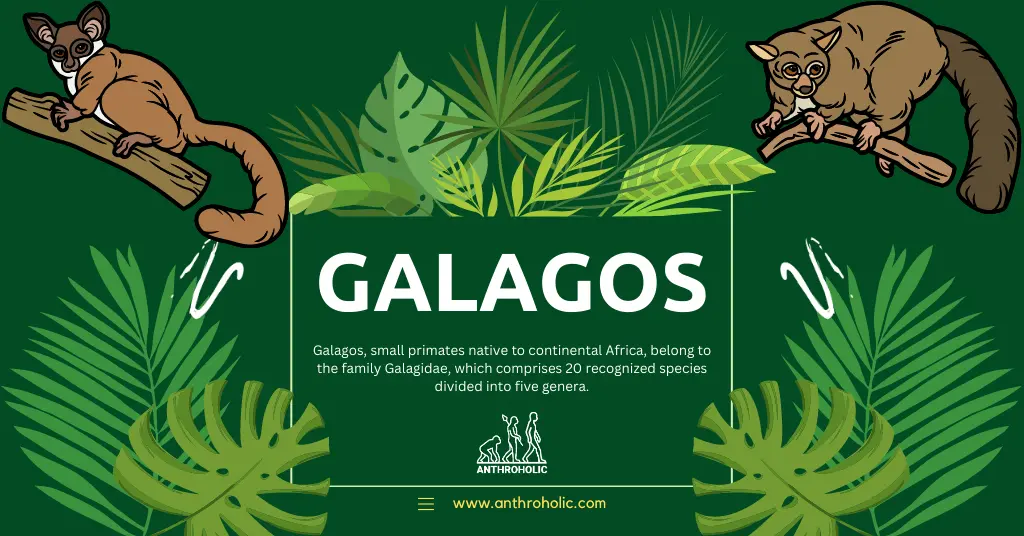AI Answer Evaluation Platform Live Now. Try Free Answer Evaluation Now
Galagos
The animal kingdom is a captivating sphere teeming with numerous exotic species. Among them are Galagos, also known as Bushbabies, famed for their nocturnal, arboreal nature and endearing appearance.

An Overview of Galagos
Galagos, small primates native to continental Africa, belong to the family Galagidae, which comprises 20 recognized species divided into five genera.
| Genera | No. of Species |
|---|---|
| Otolemur | 3 |
| Euoticus | 2 |
| Galago | 2 |
| Galagoides | 8 |
| Sciurocheirus | 5 |
Physical Attributes
These adorable creatures are compact, ranging from 15 cm to 40 cm in size, with a tail almost equal to their body length. Their average weight varies between 60g to 1.5kg.
Key physical characteristics include:
- Large, round eyes for enhanced nocturnal vision
- Long, slender limbs for agile movement in trees
- A tail for maintaining balance during leaps
- Large, bat-like ears that can rotate independently
Behavioral Traits and Habits
Galagos are predominantly arboreal, excelling in swift, graceful movement through the trees. Their agility is attributed to powerful hind limbs which enable leaps up to 2.25 meters. They are also skilled climbers, using vertical supports with remarkable speed and efficiency.
Table 2: Behavioral Traits
| Trait | Description |
|---|---|
| Diurnal/Nocturnal | Nocturnal |
| Social structure | Typically solitary, but some species live in groups |
| Communication | Use variety of sounds, olfactory and tactile signals |
Dietary Pattern
Galagos primarily feed on:
- Insects
- Fruits
- Gums from trees
- Occasionally, small vertebrates
Their diet can vary according to seasonal changes, availability of food resources, and their specific habitat.
Conservation Status
With the escalating global environmental crisis, conservation status is a pertinent topic. The International Union for Conservation of Nature (IUCN) classifies different Galago species into categories ranging from ‘Least Concern’ to ‘Endangered’.
For example, the Senegal bushbaby (Galago senegalensis) is categorized under ‘Least Concern’, while the Bioko Allen’s bushbaby (Sciurocheirus alleni) is ‘Endangered’, primarily due to habitat loss.
An In-depth Look into the Galagos’ Lifestyle
Reproductive Behavior
Galagos follow a monestrous breeding cycle, meaning females come into estrus only once a year. They usually give birth to one or two offspring after a gestation period of 110-133 days, varying with the species.
The young galagos are born with eyes open and can cling to their mother’s fur immediately. Female Galagos exhibit excellent parental care and often keep their babies in a nest or carry them in their mouth for the first few weeks.
Unique Communication System
Despite being small creatures, Galagos have a complex system of communication that includes a variety of vocalizations, scent-marking, and tactile signals. Some species are known to produce up to 18 distinct sounds, including alarm calls, territory defense sounds, and mating calls.
These vocalizations are complemented by their olfactory communication. Galagos possess specialized scent glands, with which they mark their territories and communicate their reproductive status.
Impact on Ecosystem
Galagos play a significant role in their ecosystem. Their insectivorous diet helps control insect populations, and their fruit-eating habits aid in seed dispersal, thereby contributing to forest regeneration.
In turn, Galagos are a vital food source for larger predators like owls, snakes, and large carnivorous mammals, making them an integral part of the food chain.
Cultural Significance
In some African cultures, Galagos are associated with superstitions and folklore. They are often seen as omens of evil due to their eerie vocalizations and nocturnal nature. However, with changing times and increased understanding, such superstitions are gradually fading away.
Future of Galagos: Conservation Efforts
The future of Galagos hangs in the balance. While some species are relatively safe, others face the threat of extinction due to rapid habitat loss, hunting, and the illegal pet trade.
Numerous organizations, both local and international, are working to protect these charismatic creatures. They focus on habitat preservation, promoting sustainable agriculture practices, strict regulation of the pet trade, and raising public awareness about the importance of biodiversity.
Final Thoughts
Galagos, despite being small, hold an immense place in the intricate web of life. Their survival is not just about preserving a single species but maintaining the rich biodiversity of the African continent. As we move further into the 21st century, let’s pledge to safeguard these night-time gliders and their homes.
References
- Bearder, S. (2007). Galagos or Bushbabies. In: Primates in Perspective. New York: Oxford University Press.
- Nekaris, K.A.I., and Bearder, S.K. (2011). The Lorisiform Primates of Asia and Mainland Africa. In: Primates in Perspective, 2nd Edition. New York: Oxford University Press.
- The IUCN Red List of Threatened Species. (2023). Galagos. Retrieved from: https://www.iucnredlist.org/search?query=galagos&searchType=species
- Kingdon, J., Happold, D., Butynski, T., Hoffmann, M., Happold, M., & Kalina, J. (2013). Mammals of Africa. London: Bloomsbury.
- Pullen, S., Bearder, S., & Dixson, A. (2000). Preliminary observations on sexual behavior and the mating system in free-ranging lesser galagos (Galago moholi). American Journal of Primatology, 52(1), 37-42.
- African Wildlife Foundation. (2023). Galagos. Retrieved from: https://www.awf.org/wildlife-conservation/galagos
- African Folklore. (2022). The Bushbaby in African Folklore. Retrieved from: https://www.africanfolklore.com/bushbaby-in-african-folklore/




